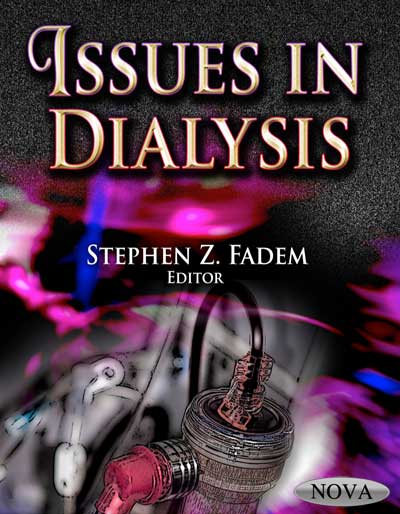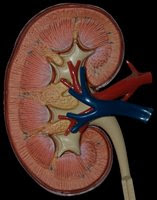...highly recommended to a broad range of readers - Nathan Levin
Nathan Levin reviews Issues in Dialysis

Current books on dialysis consists largely of two types of publications; one is handbooks of practical instruction for physicians, nurses, technicians, social workers and dietitians and the other is encyclopedic works emphasizing the physical, chemical and biological aspects of various types of dialysis and including the wide range of psychosocial issues characteristic of this interesting subspecialty of nephrology. An interesting new book, “Issues in Dialysis” edited by Stephen Z. Fadem brings together individual viewpoints on a variety of current topics. It is a substantial work of 20 chapters, generally very readable, and is a good representation of current opinion.
The book begins with the description of 20 milestones in dialysis (with emphasis on the US) by Fadem which incorporate technical progress, process, access development, dialysis as an industry, dosing of dialysis, ESAs and practice Guidelines, transplantation, and government action . Golper and Schreiber provide a powerful argument for an integrated approach to therapy in regard to modality choice and site of treatment, communication and education with patients is stressed. Amy Friedman focuses on the range of decisions implicit in the variable quality of donor kidneys and provides a novel analysis of the expectations of the stakeholders associated with transplantation including patient, surgeon, nephrologists to payer, etc. Chris Blagg contributes a characteristically polished history and evaluation of the Seattle home dialysis experience. Badve, Hawley and Johnson take up the must discussed question of clinical outcomes comparing PD and HD pointing out most evidence is derived from observational studies. In their Chapter on intensified dialysis in children, Thumfart and Muller present this approach as a promise to improve symptoms and psychosocial rehabilitation.
Victor Gura provides an impressive argument for development of a wearable artificial kidney, referring also to his considerable personal experience. In a thought provoking essay, Susan Bray deals fully with the issues involved in not automatically dialyzing everybody. She emphasizes the RPA guideline on withdrawal from dialysis and the concept of the “time limited trial”. Richard Glassock convincingly provides the basic arguments for the primacy of extracellular fluid overload as the major mechanism for development of left ventricular hypertrophy, the difficulties faced in determining its degree and possible therapeutic approaches to its eradication. In one of the few Chapters devoted to basic science, William Mitch fully but lucidly describes the enzymatic mechanisms underlying muscle wasting in kidney disease as influenced by events occurring in chronic kidney disease such as acidosis, inflammation, increased glucocorticoid production, etc. Allon Friedman, answering the question of the value of serum albumin as a useful marker of nutritional status, convincingly demonstrates its importance as rather a marker of illness. The Chapter on the deregulated immune system in dialysis patients by Grabner, Pavenstadt, Lang and Reuter is important because of the relative novelty of such reviews but also because of its breadth of topics, valuable tables and extensive references. Over activation and malfunction of the immune system is demonstrated from the early stages of CKD until loss of kidney function occurs.
Hruska, Fang and Sugatani emphasize the close relationship in CKD patients between low turnover bone disease and vascular calcification and clearly describe the roles of bone regulatory proteins and new skeletal hormones and inorganic phosphorus concentrations. New therapeutic approaches are suggested. Perhaps the most comprehensive Chapter of the book is the 30 page update on anemia and kidney disease by Goli, Pinkhasov, Landry, Chait, Horowitz, Hollot, Shreshtha and Germain. It deals in detail with the physiology of erythropoiesis in CKD, current questions of ESA dosing and resistance, iron metabolism, hemoglobin variability current controversies and much else related to this field.
The somewhat neglected field of accumulation of toxic metals and trace elements in dialysis patients is examined by Yen, Lin-Tan,and Lin. They point out the importance of trace metals, particularly lead and cadmium, but also chromium, copper and vanadium as contributing to a variety of pathological processes in patients with kidney disease.
James Tattersall’s Chapter on adequacy of dialysis is a remarkably well balanced assessment of the meaning of the term and its application. Dose, different schedules, removal of solutes of various sizes, clearances in vivo and in vitro and normalization of such in HD and PD, various models of pool size and a list of relevant RCTs are lucidly discussed and practical advice given.
Syed and Peden provide a very useful essay on the AV fistula which includes its history and the approach to create and maintain fistulae and to handle dysfunction. They point to current investigations to reduce neointimal hyperplasia and the future represented by tissue engineered blood vessels. Anaya-Ayala, Davies and Reardon define the general considerations regarding CVD and its risk factors in dialysis patients before describing pre-and post operative management and outcomes. They suggest that prevention is the most effective treatment.
Dori Schatell reviews the concept of health-related quality of life as evaluated by various measures including that of the SF36 and the Kidney Disease Quality of Life. This detailed account is singular, CMS (US government) requirements for such measurements are detailed and practical use of the instruments is clearly presented. The book ends with a succinct discussion of integrated Renal Disease Care by Franklin Maddux initiated by the Institute of Medicine’s document “Crossing the Quality Chasm” and being developed by The US Department of Health and Human Services. The task involves, inter alias, patient population identification, care coordination, CKD and ESRD interventions and eventually introduction of accountable care organizations. These may be major advances in care in the US.
The book with its international authorship and its broad range of issues, presents a fascinating picture of current writing on dialysis. It is highly recommended to a broad range of readers.





